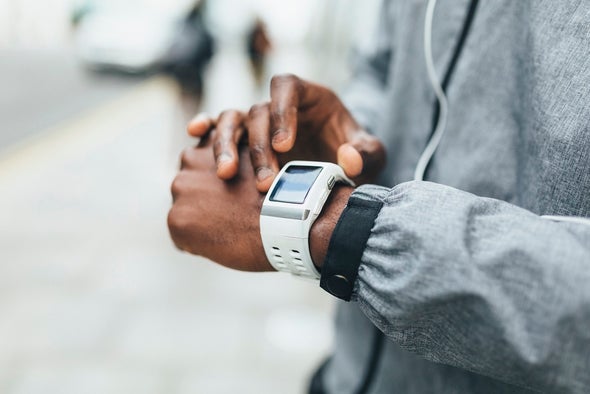(单词翻译:单击)
听力文本
This is Scientific American — 60-Second Science. I'm Christopher Intagliata.
One of the biggest drawbacks to wearing a smartwatch is how often you have to take it off to charge it. But here's an idea. How about charging it with a power source that's pretty ubiquitous nowadays: wifi?
"Wifi signals are all around us and most of them are just wasted." Xu Zhang, an electrical engineer at MIT. Writing in the journal Nature, he and his colleagues describe a device, called a "rectenna", designed to capture energy from wifi signals — and turn it into direct current electricity.
The rectenna consists of a small gold antenna — about the size of an SD card — which converts a variety of wireless signals — wi-fi, bluetooth, cellular LTE — into an AC signal. Next, a three-atom-thick layer of molybdenum disulfide converts that AC signal into usable DC electricity. That layer is called a rectifier. Slap it onto the antenna, and the result is the "rectenna."

The device is flexible and, using typical home wi-fi signals, it spits out about 40 microwatts. Enough to light up a simple LED display or power a biosensor. It's not enough juice for power-hungry smartwatches and smartphones just yet. But Zhang says their next goal is to build an array of rectennas to power larger devices.
The scientists also envision a smart city where buildings, bridges and highways are studded with tiny sensors to monitor their structural health, each sensor with its own rectenna, so it never goes dark. "We can in some sense bring intelligence to almost every object around us, and that can enable ubiquitous sensing."
Because a "smart city" becomes a lot less intelligent when it runs out of juice.
Thanks for listening for Scientific American — 60-Second Science. I'm Christopher Intagliata.
参考译文
这里是科学美国人——60秒科学。我是克里斯托弗·因塔利亚塔。
戴智能手表的最大缺陷之一是,你要经常摘下来充电。不过这里有个好想法。用现在几乎无处不在的电源wifi来给手表充电怎么样?
“我们周围到处都是wifi信号,而大部分信号都被浪费了。”麻省理工学院的电气工程师张旭(音译)说到。他和同事在《自然》期刊上描述了一种名为“整流天线”的设备,这种设备从wifi信号中捕获能量,并将其转换为直流电。
整流天线由一块记忆卡大小的金色天线组成,可以将wifi、蓝牙和蜂窝LTE等各种无线信号转换成交流信号。接下来,三原子厚的二硫化钼层将交流信号转换成可用的直流电。这个二硫化钼层被称为整流器。将其放到天线上,就形成了“整流天线”。
这一设备非常灵活,使用常见的家庭wi-fi信号,可释放出约40微瓦的电力。这足以点亮一块简单的LED显示屏或为生物传感器提供动力。但还不足以为耗电的智能手表和智能手机供电。但张旭(音译)表示,他们接下来的目标是制造一组为较大设备供电的整流天线。
科学家还想象了智能城市的情景:建筑物、桥梁和公路都镶嵌着微型传感器,以监测它们的结构健康情况,每个传感器都有自己的整流天线,因此永远不会没电。“从某种意义上说,我们可以让我们周围的所有物体都拥有智能,这会让感应变得无所不在。”
因为当电力耗尽时,“智能城市”的智能就会减少很多。
谢谢大家收听科学美国人——60秒科学。我是克里斯托弗·因塔利亚塔。
译文为可可英语翻译,未经授权请勿转载!
重点讲解
重点讲解:
1. take off 脱下,脱掉;
He wouldn't take his hat off.
他不肯摘下帽子。
2. consist of 由…组成;由…构成;
The committee consists of ten members.
委员会由十人组成。
3. convert into (使)改变;更改;(使)转变;
The signal will be converted into digital code.
信号会被转变为数字代码。
4. run out of 用完;耗尽;
They have run out of ideas.
他们已经想不出任何办法了。


